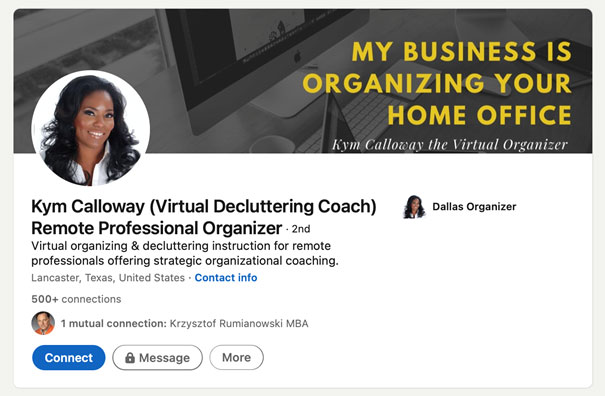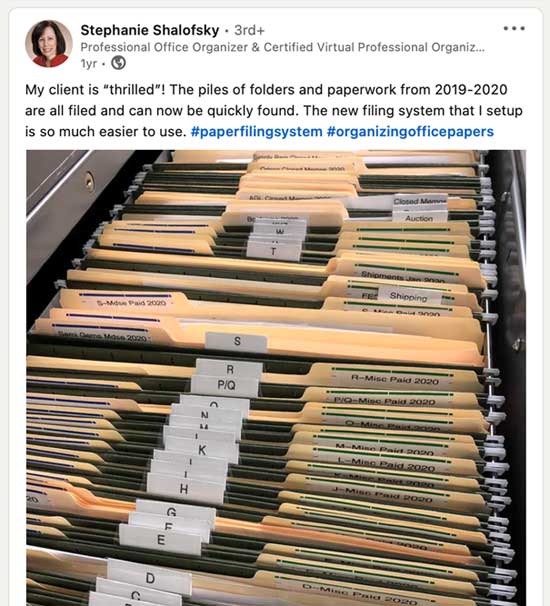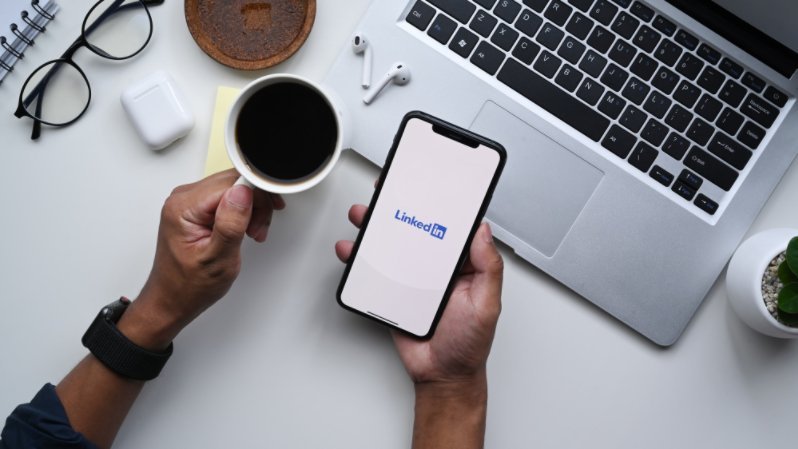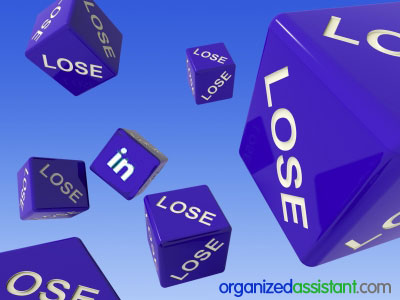How to Use LinkedIn to Build Your Brand and Find New Clients
This page may contain links to Amazon.com or other sites from which I may receive commission on purchases you make after clicking on such links. Read my full Disclosure Policy

I’ve been on LinkedIn longer than any of the other social media sites where I still participate. Despite that, I know I’m not taking full advantage of it, and I suspect you’re not either. It’s such an important platform for connecting with other businesses that I was pleased when Margo offered to write this article.

LinkedIn is one of the best channels to promote your organizer’s brand if you want to sell to B2B clients. No matter if you use LinkedIn as a freelancer or as an established company, on LinkedIn, you can reach decision-makers in companies that might be in search of your services. They are looking to organize their office spaces better or need an organizer to run productivity workshops for their team.
A good thing about corporate clients is that they might want to come back with more projects and recommend your services to colleagues from their professional circles. Also, they tend to have bigger budgets!
In this article, we are going to share some tips on building your brand on LinkedIn, so you can become a magnet for new B2B clients and projects.
1. Polish your LinkedIn profile
When you don’t have a professional LinkedIn profile yet or haven’t used your old profile for a long time, start with updating it. Make it stand out!
Start with adding your LinkedIn cover photo and make sure it follows the aspect ratio LinkedIn will ask you for. You might also want to work on the following elements of your LinkedIn profile to make it look more professional:
- a professional headshot (check the example below).
- a short job title – mention who you are and what you are doing; describe your niche
- create a summary about what makes you a great organizer in the “About” section
- add your previous experience and describe it – focus on the skills and traits that matter for an organizer. If you worked as an office assistant in your student years, make sure to add a short description saying how this experience helped you become a better organizer
Check out this profile of a professional organizer who’s applied all these tips in practice.

2. Share the outcome of your work
A great way to generate leads with LinkedIn is through sharing the results of your work. Just think about it – your potential clients would work with someone who has a successful track record and can prove their results rather than with an organizer who has nothing to brag about.
How can you explain the result of your work without sounding too self-promotional? Write brief posts describing your recent project briefly and add a relevant photo. A post without a photo would work as well. However, a photo adds a bit more authenticity.
You can check this post below for a reference.

3. Collect testimonials from past clients
Your client testimonials is another element of social proof that can convince decision-makers in organizations to get in touch with and start working together. People feel more confident about their choice when they choose a service someone else has purchased and was happy about.
On LinkedIn, testimonials can be added within the Recommendations section.

4. Connect with people every day
Make sure you have already profiled your ideal persona and know exactly who you have to target. In Advanced LinkedIn search, you can mark organizations, job titles, countries, and many other criteria to end up with a list of potential prospects you can target.

Once you have made this search, you can then start adding some contacts every day. The idea here is being consistent – add 10-30 contacts every day.
On the Internet, you might come upon some LinkedIn automation tools that would add contacts on autopilot after you grant access to your LinkedIn account. However, remember that using such tools excessively can lead to LinkedIn blocking your account, so in the end a better strategy would be adding contact on a small scale, but with more consistency (and the best is doing it manually).
Once you have added a contact on LinkedIn, write a brief welcome message mentioning the reason for connecting and introducing yourself.
Here is an example, of an introductory message:
“Thanks a lot for accepting the invitation. Often, I like to have a brief call with my new connection so we can explore how we may be able to help each other in the future.
If you are interested, I would be very happy to share some tips on organizing your office space and productivity that could benefit your team.
If you are open to an introductory call, I invite you to visit http://ScheduleaCallwithOrganizer.com and pick a time that is most convenient for you.
I am looking forward to speaking with you.”
5. Don’t sell right away
You could observe that some people on LinkedIn start pitching their services in the first or second message right after they connect with you. This simply doesn’t work these days in most cases – just the same way cold calling wouldn’t work – wouldn’t you find it annoying?
So first build relationships and show your skills and experience through your content and by engaging with posts of your connections. This way, next time you outreach your leads suggesting to explore the ways to cooperate, this won’t sound too pushy.
Make sure you publish posts that are informative and non-promotional, sharing the tips that can be useful for your audience. Also, a good idea would be to diversify your educational content with some interesting story about your job and lessons you have learnt. Just remember there should be some interesting twist in it!
Before you ever pitch anyone on LinkedIn, your contact should already have an awareness and opinion about you as an experienced professional. If you pitch everyone your services, most of the contacts might not even have a certain problem where they would need your help, others might have a problem, but are simply not aware of it.
Your job here is educating on what impact your work can have on companies’ wellbeing and productivity, so in the end your contact needs just a small final push to get in touch with you.
6. Engage with your new contacts’ content
Apart from posting educational content on LinkedIn, make sure you also engage with the posts your connections publish on their LinkedIn profiles. When their company gets featured in some ranking or wins an award, share it on your profile by reposting their content. They will definitely appreciate your support and remember you!
When commenting under the posts of your target customers, be authentic. Instead of writing generic “Good job! ” or “I agree with you.”, put in some effort in sparking the discussion around the mentioned subject and engage in a virtual talk with the contacts who might eventually order your organizer services.
Implementing this point is tough unless you make your LinkedIn activity your routine and spend 5-15 minutes on scrolling the feed and engaging under interesting posts every day. However, once you nail it, you will start building genuine relations with your leads and get them to like you.
7. Use triggers to build a more targeted communication
One of the reasons for not getting a response from LinkedIn acquaintances is bad timing and a lack of context. At the time your connections receive your message, they can be busy or simply wouldn’t care to respond to a message from a stranger.
If you want to make your conversations on LinkedIn more personal and contextual, consider using trigger events to contact your leads. Let’s see what a trigger event is in this case using a few examples:
- Viewing your profile
- Changing job
- Getting promoted
- Liking your post or commenting
- Their company is mentioned in the news
Prepare some message drafts that you would send to a LinkedIn connection as a response to these trigger activities. You should also set aside some time every few days to write messages in response to the trigger events.
8. Promote your profiles
Often, you need to create multiple touchpoints with a potential client to get them to buy from you. Your LinkedIn activity can be one of them. Let’s first see how LinkedIn can become another important touchpoint with a lead leading to sales.
Your past client is making an email introduction to a person who is looking for organizer services. By adding the LinkedIn logo to your email signature, the person who’s been in touch with you can easily check your profile to learn more about you. Then, they would read some of the content you have published recently, check your recommendations, and finally get inspired to work with you.
If you are doing mass email outreach using Gmail or another email provider, having your LinkedIn link at the bottom of the message can translate in more trust of the contacts who you are approaching by email and who haven’t interacted with you before.
Also, If you use your Facebook profile to contact customers, you can promote the posts you publish on LinkedIn there. Also, remember to add social buttons, including LinkedIn, on your webpage, so people can quickly access it.
Wrapping up
It takes time and effort to build trust on LinkedIn. However, if you don’t sell to LinkedIn connections right away but instead focus on showing your expert image first, you will earn trust quickly. Consider implementing a few tips from the list we have compiled for you, and see the results for yourself!




I love that specific job description under her image. I don’t use LinkedIn as much because my business is geared toward residential customers. Still, I know people look me up there to see my background, so I do try and maintain a presence. Excellent tips!
Aren’t they great? I can’t wait to put some of them in action.
Great tips for making the most of your LinkedIn profile – I’m sure a lot of us aren’t using it to the fullest advantage. Thanks so much for the tips, they are the nudge I needed to make some updates! 🙂
You and me both, Laura! It’s been on my task list for longer than I care to admit.
What a great reminder to make the most use of LinkedIn. I set my profile up many years ago and tweaked it a bit a few years back but it has been largely neglected.
Time to get back into the game!
I think that happens a lot. I often see notifications that I should congratulate someone for being in a job for 20 years, when I know they haven’t been in that role for at least 5…
Great ideas to help get noticed on LinkedIn! LinkedIn just started LinkedIn Live Video, which allows approved members and Pages to broadcast live video content to a LinkedIn profile, LinkedIn Page, or Event. I haven’t tried it yet but signed up myself. It may also be a good option for POs.
Sabrina, you are a wealth of information! How on earth do you stay on top of these things?
I know I have neglected engagement on LinkedIn, mostly because of those cold call-type pitches that she mentioned above. They are a serious turnoff for me. That said, I do try to keep my profile as up to date as possible, and I could stand to explore the platform in a more positive light. This post really gives some great ideas for how to begin.
I’ve stopped accepting connection requests from anyone who doesn’t give a compelling reason why we should connect, unless of course I already known them. The ones that have no note or simply a vague “we should connect” almost always lead to those pitches. I can’t imagine they actually work for anyone!
There is so much good advice here, and I know I’ve dramatically underutilized LinkedIn for several years. A client had to reschedule tomorrow’s session, so I’m putting this post on my to-do list to follow through on all the things I need to refresh in my profile and tactics I need to start implementing. (I did stop and make the banner background my signature color rather than the default grey. How have I never noticed that?
Probably because you never look at your profile, just your news feed. Wasn’t that easy?